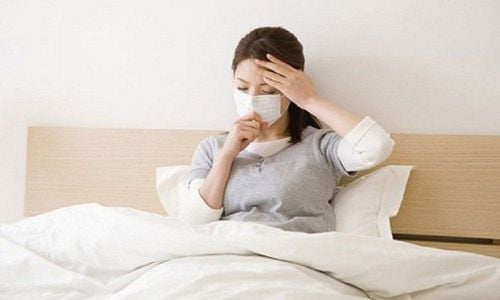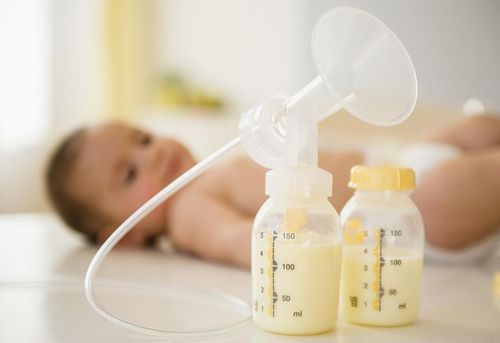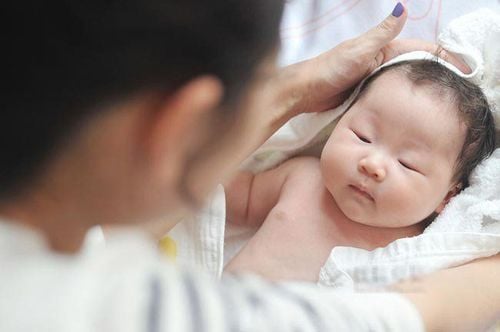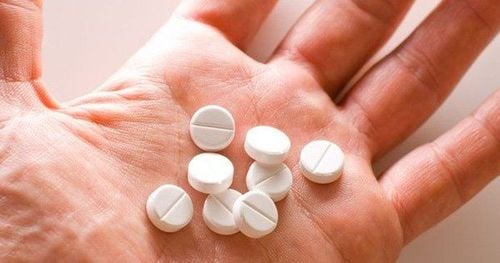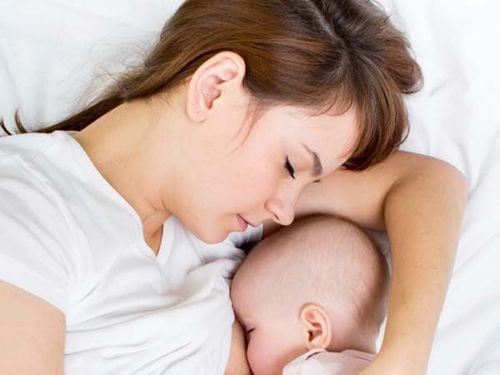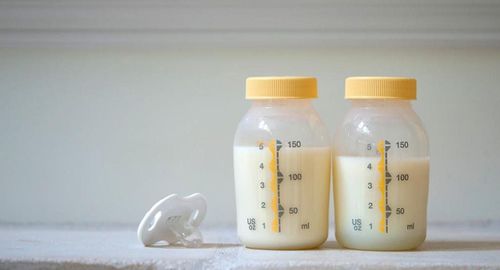This is an automatically translated article.
Cracked or bleeding nipples cause many mothers pain while breastfeeding. Therefore, when encountering this situation, the mother should not suffer but need to go to the nearest medical facility to examine, find out the cause and be consulted for appropriate treatment, to avoid dangerous complications. may happen.
1. Causes of cracked and bleeding nipples
Usually, bleeding nipples are not a cause for concern. This is usually the result of some kind of trauma or friction, such as the nipple's rubbing against a bra or an easily scratched shirt. Blood or abnormal nipple discharge is relatively common, even when you're breastfeeding. About 5% of women require treatment for breast-related symptoms because of abnormal nipple discharge.
For first time moms, breastfeeding can take some time to master. For the first few days, your nipples may be sore and cracked. There may be bleeding cracks on the nipple or the area around the nipple (areola).
But breastfeeding won't cause pain or bleeding. If your nipples continue to bleed during the first few days or weeks of breastfeeding, it could be because your baby is not latching on properly.
Other signs of a poor latch on your baby include:
Flat, wedge-shaped or white nipple at the end of a feed Severe pain during each feed Baby seems hungry after feeding The bottom of the areola is not lying in your baby's mouth If you've been breastfeeding for a few months and suddenly have pain, it could be a sign of an infection. To handle this case, you can try the following measures:
Check the baby's latch: The best latching position is off-centre and the baby can latch on more of the areola below the nipple. One way to achieve this is to point your baby's nose up to your nipple so that the baby's bottom gums are away from the base of the nipple when he opens his mouth. When your baby opens his mouth, quickly hug him. The nipple will be pushed deep into the baby's mouth. Try different breastfeeding positions. You may find that certain positions, such as having your baby on your lap, lying on your side, make it much easier and more comfortable for your baby to latch on properly than others. Feed on the less vulnerable side first. Newborns often suckle more gently from the other breast when they are less hungry. You can also try limiting breastfeeding to less than 10 minutes on the affected side. Apply a cold pack quickly to numb the injured nipple area before breastfeeding. Cold can help relieve pain, especially when initiating breastfeeding tends to be the most painful. Breastfeed your baby often. Breastfeeding after two to three hours can help prevent breast engorgement. Pump milk before breastfeeding. If you're having trouble engorgement causing your nipples to become shallow, you can pump a minute or two before breastfeeding to prepare your baby's nipples for better latching. Limit breastfeeding time. Some babies will continue to latch on to the breast even without extra milk, which can irritate the skin. Listen to your baby swallow and when he stops swallowing, gently remove him from your breast. You can also try limiting the length of feeds to 10 to 15 minutes on each side. If you have limited time to breastfeed, consider hand expressing or pumping to maintain a long-term milk supply.

Hút sữa làm tăng nguy cơ núm vú nứt và chảy máu
2. Otherwise the skin is cracked
Bleeding can also be caused by skin conditions that cause dryness and cracking, such as contact dermatitis or dry skin. Contact dermatitis occurs when the skin comes into contact with an irritant. It could be new soap, laundry detergent, or an industrial cleaner on a new bra.
Dry skin is often caused by exposure to cold temperatures. For example, nipples can become dry and cracked from exposure to hot water in the shower. This irritation can be aggravated by tight clothing.
Other symptoms may include: itching, rash, scaly skin, blisters. First, you should try to identify the cause of your nipple irritation and avoid them. In general, fragrance-free products tend to be gentler on sensitive skin. A warm bath is also better than a hot bath.
When the skin is cracked, it's important to prevent infection. Keep the area clean with soap and water and apply an antibiotic ointment, such as Neosporin, until the wound heals. If the condition persists, see your doctor and may be prescribed prescription creams.
3. Piercing or other trauma
If you have a breast piercing it takes two to four months to heal, during which time the nipple may bleed. An infection can develop both during and after healing, and can also cause a collection of pus (abscess) to form inside the nipple or areola.
Any part that cracks the skin can cause bleeding and lead to infection. Most nipple piercings are done under sterile conditions, but other injuries to the nipple can introduce bacteria. This can happen during rough nipple stimulation, especially when the skin is cracked from bites, nipple clamps, or other sex toys.
Symptoms of an infection include:
Redness and inflammation Pain or tenderness to the touch Unusual discharge or discharge In this case, you should keep the area around your piercing or wound as clean as possible. good. Wash with soap and warm water or an antiseptic wash, such as Bactine. Soaking the piercing in a solution of warm water and salt several times per day can also help treat and prevent infection.
If you have an abscess or severe pain, you should see a doctor immediately. Your doctor can drain the abscess and prescribe oral antibiotics.
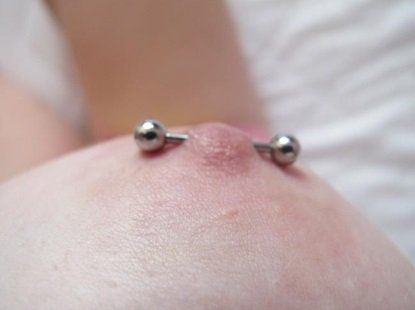
Xỏ khuyên vú khiến núm vú có thể bị chảy máu.
4. Breast Infection
Mastitis is an infection of the breast that causes pain and redness. This condition is most common in women who are breastfeeding, but can happen to anyone. This condition usually occurs within three months of giving birth.
Mastitis does not usually cause bleeding, but nipples are often cracked and damaged. If there is bleeding, it is an entry point for bacteria, which can lead to a breast infection.
Symptoms of mastitis include:
Breast tenderness or tenderness Warm to the touch Flu-like sensation Breast swelling or lumps Pain or burning while breastfeeding Breast redness Fever and chills In this case, if you suspect If you have mastitis, see your doctor. Most cases are treated with oral antibiotics for 10 to 14 days. You should feel better within the first few days, and your condition should improve over the next week or two.
Your doctor will prescribe antibiotics that are safe for a nursing baby and you should continue to breastfeed your baby. If an abscess develops near the nipple, you may need to drain the abscess. Your doctor may prescribe additional medications to treat pain and reduce fever with over-the-counter (OTC) pain relievers and medications to reduce swelling. Common medications include ibuprofen (Advil) and naproxen (Aleve).
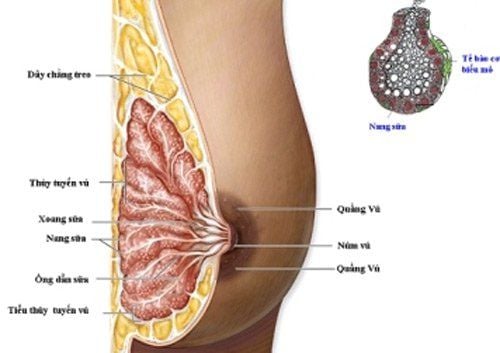
Nhiễm trùng vú là nguyên nhân dẫn đến núm vú bị chảy máu
5. Intraductal papilloma
Papilloma is one of the most common causes of nipple bleeding, especially if blood comes out of the nipple, similar to milk. They are benign (non-cancerous) tumors that develop inside the milk ducts.
These tumors are small and wart-like. You may feel it behind or to the side of the nipple. They are usually quite close to the nipple, which is why they cause bleeding and discharge.
Other possible symptoms include: clear, white or bloody nipple discharge, pain sensation. If bleeding is coming from the nipple directly, see your doctor. Your doctor can make a diagnosis from your symptoms and advise you on next steps. If you have been diagnosed with a papillomatosis, your doctor may recommend surgical removal of the affected ducts.
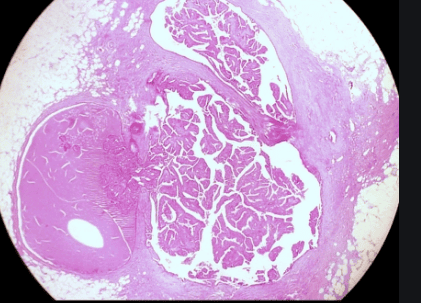
Hình ảnh u nhú lòng tuyến
6. When should you see a doctor?
Painful breastfeeding is often associated with both early weaning and postpartum depression. Schedule a check-up with your doctor if:
A cracked nipple is still painful and bleeding after 24 hours. You have a fever, inflammation, discharge, pus, soft blisters, or other signs of infection. Bacteria can enter through an open wound and lead to a breast infection such as mastitis. Cracked or bleeding nipples with pain that interfere with breastfeeding. Seek treatment from your doctor or lactation consultant as soon as possible if you have this condition. Bleeding, cracked nipples are a common problem experienced by many mothers while breastfeeding. Depending on the condition and symptoms such as fever, inflammation, and pus discharge, the mother needs to go to medical facilities for examination and treatment.
Vinmec International General Hospital is the address for examination, treatment and prevention of many diseases, including Obstetrics and Gynecology. Therefore, if after giving birth, the mother encounters difficulties in taking care of her children, recovering her health, worrying about postpartum nutrition, cracked nipples, etc., she can come to Vinmec to visit. Check and get the best advice from doctors. With the dedication and enthusiasm of the medical team, modern facilities will definitely make you satisfied.
Please dial HOTLINE for more information or register for an appointment HERE. Download MyVinmec app to make appointments faster and to manage your bookings easily.
Reference sources: babycenter.com, healthline.com




